Abraliopsis sp. V
Lourdes Burgess and Richard E. YoungIntroduction
Abraliopsis (Pfefferiteuthis) sp. V is one of the more distinctive species in the subgenus. Its size is a bit smaller than other members of the subgenus, reaching lengths of 28 mm ML in males and 35 mm ML in females. Known in the Central North Pacific from the equator to Hawaii (rare in Hawaii) and also a single record near New Guinea.
Brief diagnosis:
An Abraliopsis (Pfefferiteuthis) ...
- without keels or carpal flaps on tentacular clubs.
- with largest ventral hooks of tentacular clubs about 2 times height of dorsal counterparts.
- with many scattered photophores in Lateral Head Sector; mostly located in anterior half of sector and at base of Central Arm IV Sector.
Characteristics
In addition to familial characters (listed on the Enoploteuthidae page) and generic characters (listed on the Abraliopsis page), Abraliopsis sp. V has:- Arms
- Females
- Hooks on arms I largest and with enlarged median processes.
- Arms without tubercles.
 Click on an image to view larger version & data in a new window
Click on an image to view larger version & data in a new window
Figure. Ventral view of arms I (the two middle arms) and II of a female Abraliopsis sp. V (33 mm ML, paratype) showing the larger size of the hooks on arms I. Insert: Side (left) and front (right) views of a large arm I hook showing the vane-like median process.
- Males
- Arms I without enlarged hooks and hooks without strong median process. Hooks nearly aligned in single series over much of arm.
- Arms longer in males and with more hooks.
- First basal sucker, arms III, ventral series much larger than second basal sucker of same series and about equal in size to counterpart in dorsal series. Basal suckers 2-4 of arms III, dorsal series much larger than counterparts of ventral series.
- Left arm IV highly modified: enlarged ventral protective membrane with 12-18 large trabeculae reaching up to 2.5 mm in length. Dorsal trabeculae and membrane much shorter; first few proximal trabeculae larger, size diminishes distally and membrane nearly absent. Hooks with varying sizes depending on arm position. Arm with numerous tubercules.
- Hectocotylus (right arm IV) with large ventral flap and smaller, offset dorsal flap. Hooks with varying sizes depending on arm position. Arm with numerous tubercules.
- Arms I without enlarged hooks and hooks without strong median process. Hooks nearly aligned in single series over much of arm.
- Females
- Tentacles
- Clubs relatively short and without keels or carpal flaps.
- Carpus with 2-4 suckers and pads.
- 2-4 large ventral hooks, 2-4 smaller dorsal hooks.
- Largest ventral hook of club about 2X dorsal counterpart in height.
- Fins
- Fins large, 73-79% of ML.
- Fins large, 73-79% of ML.
- Photophores
- Ocular photophores: 5 ocular photophores, with end members about twice diameter of adjacent photophores.
- Integumental photophores: 3 series on ventral head; 6 series on ventral mantle.
 Click on an image to view larger version & data in a new window
Click on an image to view larger version & data in a new window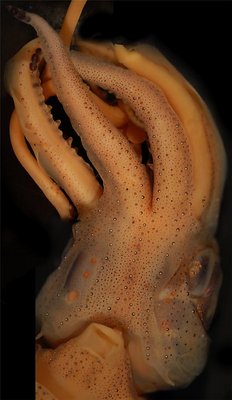
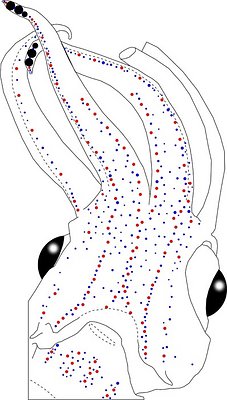
Figure. Ventral views of the integumental photophores of Abraliopsis sp. V, mature male, 30 mm ML, tropical Pacific. Left - Photograph of the preserved squid. Right - Outline drawing from photograph with all integumental photophores represented by colored dots. Red dots - Complex photophores. Blue dots - Non-complex photophores. Images by R. Young.
Detailed information on the integumental photophores can be found here.
- Viscera
- Spermatangia receptacles - Females with single pocket (stellate pocket) for storing spermatangia located in midline between anterior end of gladius and visceral mass. Dorsal collar area lacks pigmentation and folds indicating that it is not a receptacle.
- Spermatophore:
- Measurements and counts:
TC 44, sta. 18
TC 44, sta. 18
TC 48, loc. B
TC 43, sta. 22
TC 46, sta. 27
TC 46, sta. 23
Sex
Female
??
Female
Male
Male
Male
Mantle length
33
33
32
28 30
30
Head width index
30
33
36
36
37
37
Fin Length index
76
64
73
79
70
73
Fin width index
94
97
103
93
100
100
Arm Length index (R/L):
I
39/33
39/-
36/-
39/-
43/-
43/-
II
36/36
39/-
45/-
46/-
50/-
50/-
III
39/-
36/-
42/-
39/-
47/-
53/-
IV
49/49
42
46/46
57/61
53/60
57/63
No. arm hooks (R/L):
I
16/-; (22)
19/-; (21)
15/-; (24)
23/-
23/-; (15)
22/-
II
19/-; (16)
21/-; (15)
18/-; (21)
26/-
27/-; (12)
24/- III
18/-; (12)
18/-; (12)
18/-; (20) 26/-
24/-; (8)
24/-
IV
23/23
22/22 22/-
31/40
26/43
25/36
Club length index (R/L)
18/18 18/20
20/-
20/-
20/20
20/18
Club hooks (D/V)(R:L)
3/4; 3/4
4/3; 4/3
3/3
3/3; 4/3
3/3; 4/3
4/3; 4/3
Carpal suckers (R/L)
3/4
4/5
4/-
4/4
4/4
4/4

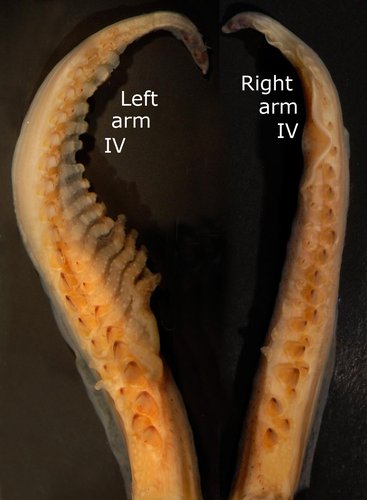
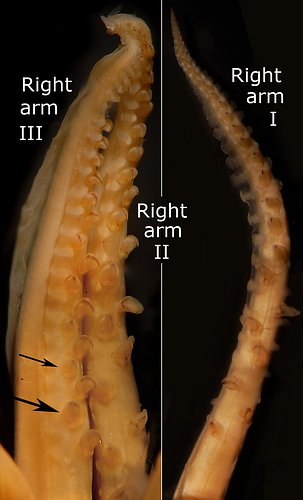
Figure. Oral views of arms III and IV of Abraliopsis sp. V, mature male, 30 mm ML, central Equatorial Pacific. Note the relative size of the two basal hooks of arm III, ventral series (arrows). Photographs by R. Young.
Comments
While the abundance of blue photophores in the Lateral head and Central Arm IV Sectors is unique among A. (Pfefferiteuthis) spp., it is similar to that found in A. (Micrabralia) spp. NC1 and NC2. Therefore the identification of females (lack the characteristic A. (Pfefferiteuthis) male arms IV) requires some care. The tentacle clubs are similar only to those of A. falco within the subgenus but they are similar to those of A. lineata within A. (Micrabralia). The most distinctive feature of females, unique to this species, is the enlargement of hooks on arms I.
Comparisons of all species in the subgenus can be found on the Abraliopsis (Pfefferiteuthis) page.
Distribution
A. (Pfefferiteuthis) sp. V is presently known only from the central tropical Pacific. Most (66 of 69) squid captured came from 17 stations located near 7°145°W and 12°N 145°W.Title Illustrations

| Scientific Name | Abraliopsis sp. V |
|---|---|
| Location | Central Equatorial Pacific at 0°29'N, 145°05'W |
| Specimen Condition | Preserved |
| Identified By | Lourdes Burgess |
| Sex | Male |
| Life Cycle Stage | Mature |
| View | Ventral |
| Size | 30 mm ML |
| Collection | NMNH 729696 |
| Type | Paratype |
| Image Use |
 This media file is licensed under the Creative Commons Attribution License - Version 3.0. This media file is licensed under the Creative Commons Attribution License - Version 3.0.
|
| Copyright |
©

|
About This Page

University of Hawaii, Honolulu, HI, USA
Correspondence regarding this page should be directed to Lourdes Burgess at and Richard E. Young at
Page copyright © 2014 and
 Page: Tree of Life
Abraliopsis sp. V.
Authored by
Lourdes Burgess and Richard E. Young.
The TEXT of this page is licensed under the
Creative Commons Attribution-NonCommercial License - Version 3.0. Note that images and other media
featured on this page are each governed by their own license, and they may or may not be available
for reuse. Click on an image or a media link to access the media data window, which provides the
relevant licensing information. For the general terms and conditions of ToL material reuse and
redistribution, please see the Tree of Life Copyright
Policies.
Page: Tree of Life
Abraliopsis sp. V.
Authored by
Lourdes Burgess and Richard E. Young.
The TEXT of this page is licensed under the
Creative Commons Attribution-NonCommercial License - Version 3.0. Note that images and other media
featured on this page are each governed by their own license, and they may or may not be available
for reuse. Click on an image or a media link to access the media data window, which provides the
relevant licensing information. For the general terms and conditions of ToL material reuse and
redistribution, please see the Tree of Life Copyright
Policies.
- First online 03 November 2013
- Content changed 21 January 2014
Citing this page:
Burgess, Lourdes and Richard E. Young. 2014. Abraliopsis sp. V. Version 21 January 2014 (under construction). http://tolweb.org/Abraliopsis_sp._V/144251/2014.01.21 in The Tree of Life Web Project, http://tolweb.org/




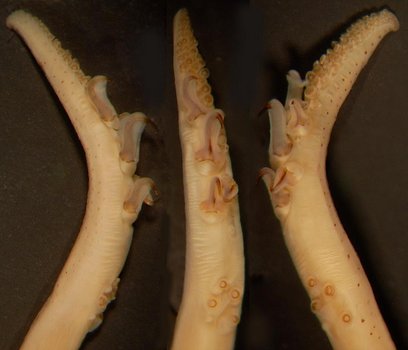

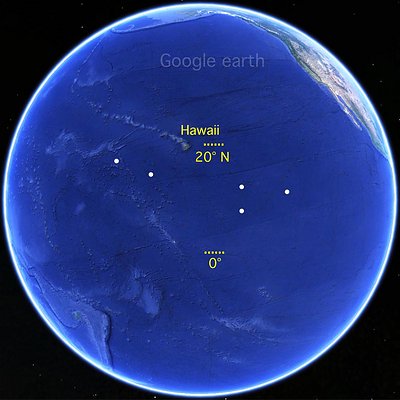


 Go to quick links
Go to quick search
Go to navigation for this section of the ToL site
Go to detailed links for the ToL site
Go to quick links
Go to quick search
Go to navigation for this section of the ToL site
Go to detailed links for the ToL site